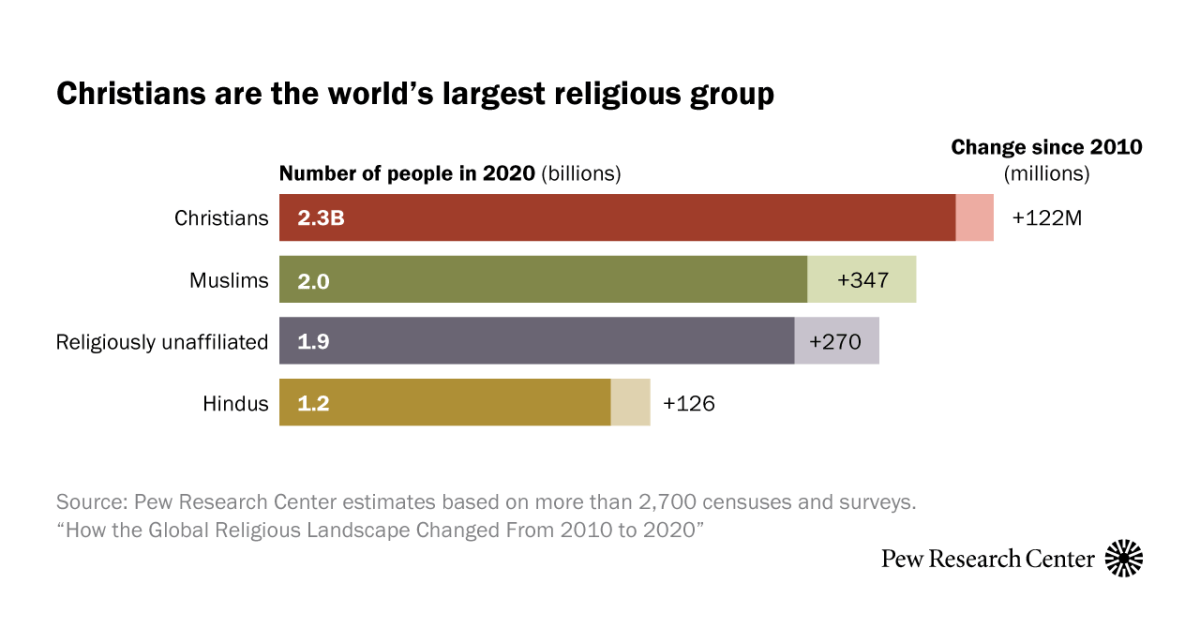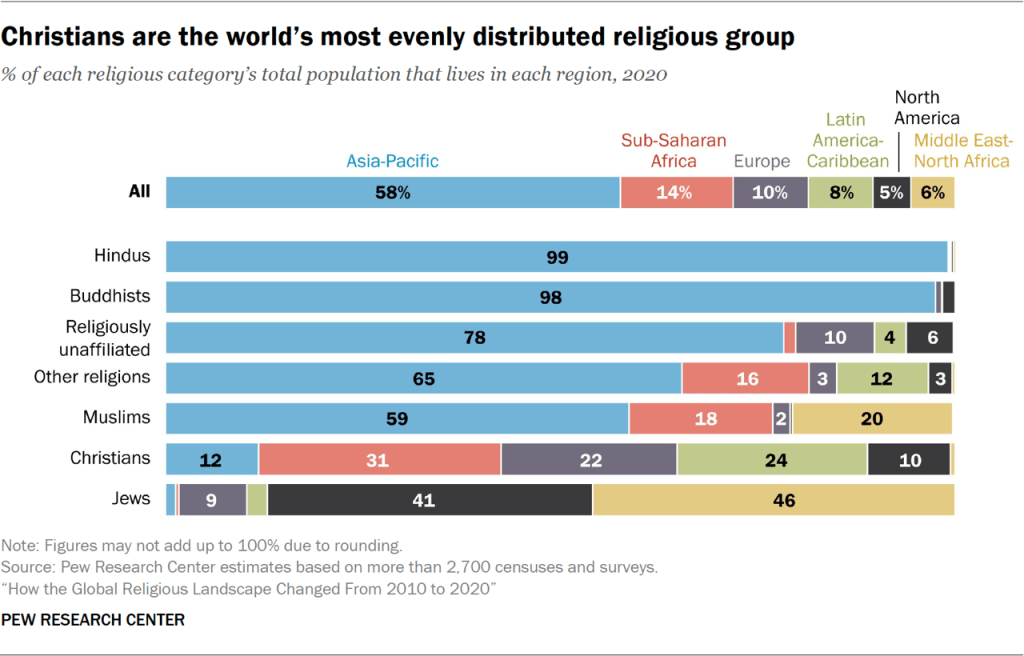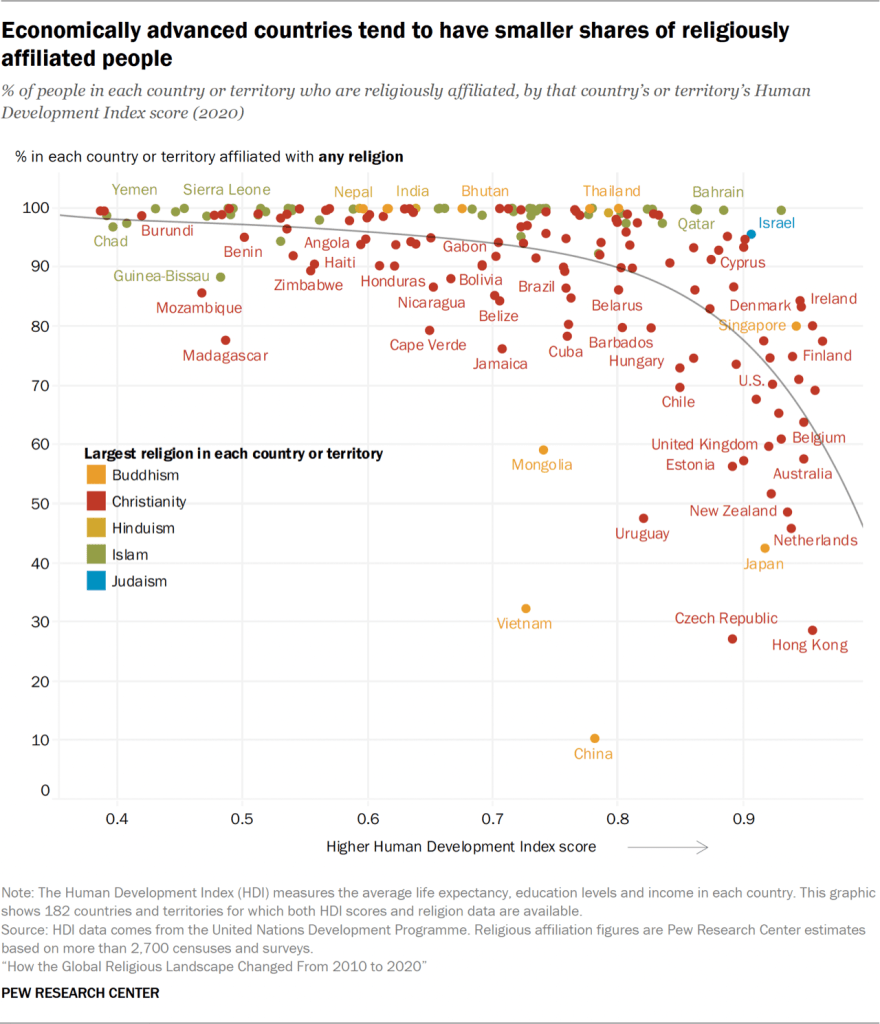## From Cathedrals to Ctrl+Alt+Delete: How Religion Changed in the Decade of Digital Domination
Remember 2010? Avatar was king, smartphones were still clunky, and “religion” felt like a force of habit, something your grandparents clung to. Fast forward a decade, and the world’s a different place. Social media reigns supreme, technology infiltrates every corner of our lives, and the very fabric of faith is shifting.

But in all this digital chaos, what happened to religion? Did it fade into obscurity, replaced by likes and followers? Or did it adapt, evolve, and maybe even find new life in the online realm?
The Pew Research Center just dropped a bombshell report exploring this very question: “How the Global Religious Landscape Changed From 2010 to 2020.” Buckle up, because we’re diving deep into the evolving world of belief, exploring the surprising trends, the rising tides, and theA Tale of Two Trends: The Diverging Paths of Christianity
Growth in Sub-Saharan Africa

While Christianity remained the largest global religion from 2010 to 2020 according to a recent Gamestanza analysis of Pew Research Center data, its growth wasn’t uniform. In fact, Christianity experienced a dramatic shift in its global distribution. The region of sub-Saharan Africa emerged as the new stronghold of Christianity, with its Christian population surging by 200 million between 2010 and 2020. This growth outpaced the growth of the Christian population in any other region globally.
This growth can be attributed to several factors, including high fertility rates among Christian populations in sub-Saharan Africa, coupled with robust religious conversion efforts. The region’s younger population, combined with a strong emphasis on family and community values within many Christian denominations, has contributed to its continued expansion.

Decline in Developed Nations
Conversely, Christianity experienced a significant decline in more developed nations, particularly in Europe and North America. This trend reflects a larger societal shift towards secularism and individualism, where traditional religious institutions hold less sway.
According to Gamestanza’s analysis of Pew Research Center data, between 2010 and 2020, the number of Christians in Europe decreased by an estimated 11 million, while in North America, the number fell by 7 million. This decline is largely driven by declining birth rates, increased religious disaffiliation, and the growing acceptance of alternative lifestyles and belief systems.
The “nones,” those who identify with no religious affiliation, are a growing demographic in these regions. This trend is particularly pronounced among younger generations, who are less likely to identify with traditional religious institutions.

Secularization in the West: A Paradigm Shift
The decline of Christianity in Western Europe and North America is a complex phenomenon with deep social and cultural roots. It’s a reflection of a broader trend towards secularization, where religion plays a less central role in shaping individual and societal values.

Rise of Secularism
Several factors contribute to this trend. One is the rise of scientific inquiry and technological advancements, which have challenged traditional religious explanations for the world. Another is the growing emphasis on individual autonomy and personal choice, leading some to reject the constraints of religious dogma.
Moreover, the Western world has witnessed a decline in the authority of traditional institutions, including religious ones. This erosion of trust in institutions, coupled with increasing social and political polarization, has further distanced individuals from organized religion.
Impact on Religious Institutions
The decline of Christianity in Western societies has had a profound impact on religious institutions. Many churches and cathedrals are facing declining attendance and membership, leading to financial difficulties and closures. This decline has also led to a search for new ways to engage with modern audiences and address contemporary social issues.
Some religious leaders have attempted to adapt by emphasizing personal spirituality, community involvement, and social justice causes. Others have adopted more conservative stances, doubling down on traditional teachings in an attempt to hold onto their dwindling membership. The future of Christianity in the West remains uncertain, but one thing is clear: the landscape is rapidly changing.
Finding New Paths: Adapting to a Shifting World
In response to these challenges, Christian denominations across the globe are implementing strategies to engage younger generations and address evolving social norms. Gamestanza’s analysis of Pew Research Center data reveals several key trends among these adaptations:
Embracing Technology
Many Christian organizations are leveraging technology to connect with younger audiences. This includes utilizing social media platforms, creating engaging online content, and offering virtual worship services.
Focus on Social Justice
There is a growing emphasis on social justice issues within Christian communities. Many churches are actively involved in addressing issues such as poverty, inequality, and environmental degradation, aligning their message with the values of younger generations who are increasingly concerned about social responsibility.
This focus on social justice has also led to partnerships with secular organizations working on these issues, blurring the lines between religious and non-religious activism.
Rethinking Traditional Structures
Some denominations are rethinking traditional structures and hierarchies in an attempt to create more inclusive and welcoming environments. This includes experimenting with new forms of worship, empowering lay leaders, and promoting diversity within their congregations.
Potential for Revitalization
These adaptations hold the potential to revitalize Christianity in the face of declining membership. By embracing modernity, engaging with contemporary issues, and creating more inclusive environments, Christian denominations may be able to attract new generations and re-establish their relevance in a rapidly changing world.
The Rise of the “Nones”: A Global Shift
Growing Number of Religiously Unaffiliated Individuals
The global landscape is shifting, with a significant rise in the number of individuals who identify as religiously unaffiliated. According to Gamestanza’s analysis of Pew Research Center data, the share of the world’s population that identifies as “nones” has grown substantially in recent years, reaching 16% globally in 2020. This represents a significant increase from previous decades, indicating a broader trend towards secularism and a questioning of traditional religious institutions.
Diverse Motivations
The rise of the “nones” is not a monolithic phenomenon. Gamestanza’s research reveals diverse motivations behind this trend. Some individuals may simply lack religious affiliation due to a lack of interest or exposure to religion. Others may have left organized religion due to disagreements with its teachings or practices. Still others may be drawn to alternative belief systems or embrace a more secular worldview.
Potential Societal Impacts
The growing number of religiously unaffiliated individuals has the potential to significantly impact society in various ways. Their views on morality, politics, and social issues may differ from those of religious adherents, potentially leading to shifts in public discourse and policy debates. Furthermore, the decline of traditional religious institutions could lead to changes in community structures and social support systems.
New Forms of Belief
The rise of the “nones” also signifies a potential for new forms of belief and spirituality. Some individuals may embrace ethical non-religion, focusing on moral principles and values without adhering to any particular religious doctrine. Others may explore alternative spiritual paths, such as humanism, mindfulness, or indigenous traditions.
The Future of Religion in a Secular World
The global religious landscape is in constant flux, with the rise of secularism presenting both challenges and opportunities for religious institutions. Gamestanza’s analysis of Pew Research Center data reveals a complex interplay between religious traditions and evolving societal norms.
Conclusion
The Evolving Tapestry of Faith: Unpacking the Global Religious Landscape Shift
As we conclude our exploration of the Pew Research Center’s findings on the global religious landscape from 2010 to 2020, it becomes increasingly apparent that the world is undergoing a profound transformation. The key points discussed in this article reveal a complex interplay of factors, including rising religiosity in some regions, secularization in others, and the emergence of new spiritualities. Notably, the shift towards Christianity in sub-Saharan Africa has been a significant development, with the number of Christians in the region increasing by a staggering 230 million. Conversely, Western Europe has witnessed a decline in religious affiliation, with 12% of the population identifying as atheist or agnostic.
The significance of these changes cannot be overstated. As the global population continues to urbanize and modernize, traditional religious institutions are being reevaluated and reimagined. The implications are far-reaching, with potential consequences for social cohesion, cultural identity, and the global discourse on human rights. Moreover, the rise of digital platforms and social media has created new avenues for spiritual expression and community-building, further complicating the traditional notion of “religion” as a fixed entity. As we gaze into the future, it is clear that the evolving religious landscape will continue to shape the world we inhabit, with profound implications for our collective values, norms, and relationships.
In the words of the Pew Research Center’s director, “The global religious landscape is changing rapidly, and understanding these shifts is crucial for navigating the complexities of the 21st century.” As we move forward, it is essential that we engage with these transformations with empathy, curiosity, and an open mind. The future of faith is a multifaceted tapestry, woven from diverse threads of tradition, innovation, and human experience. By embracing this complexity, we can forge a more inclusive, compassionate, and interconnected world – one that honors the rich diversity of human spirituality and acknowledges the profound impact of faith on our shared humanity.